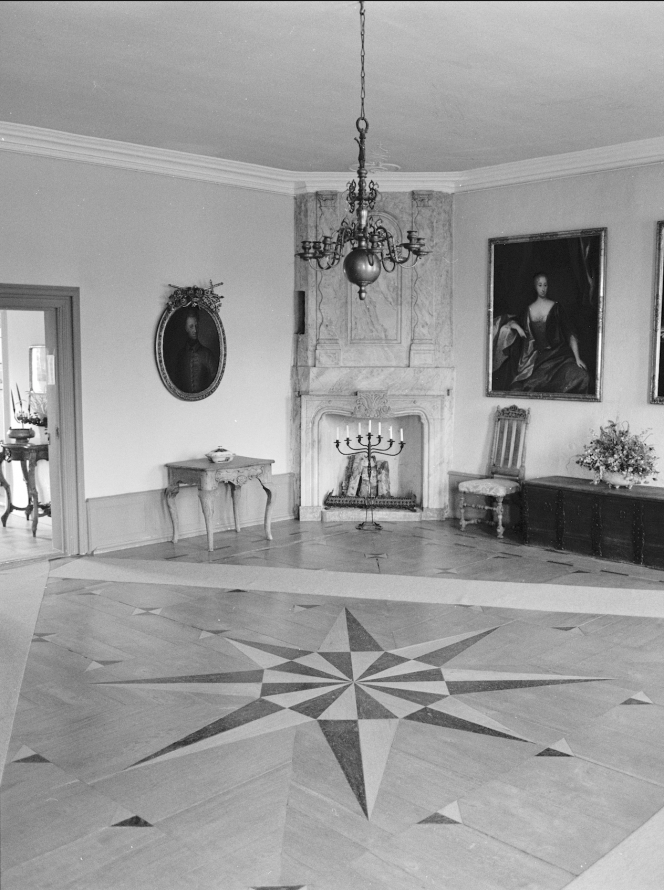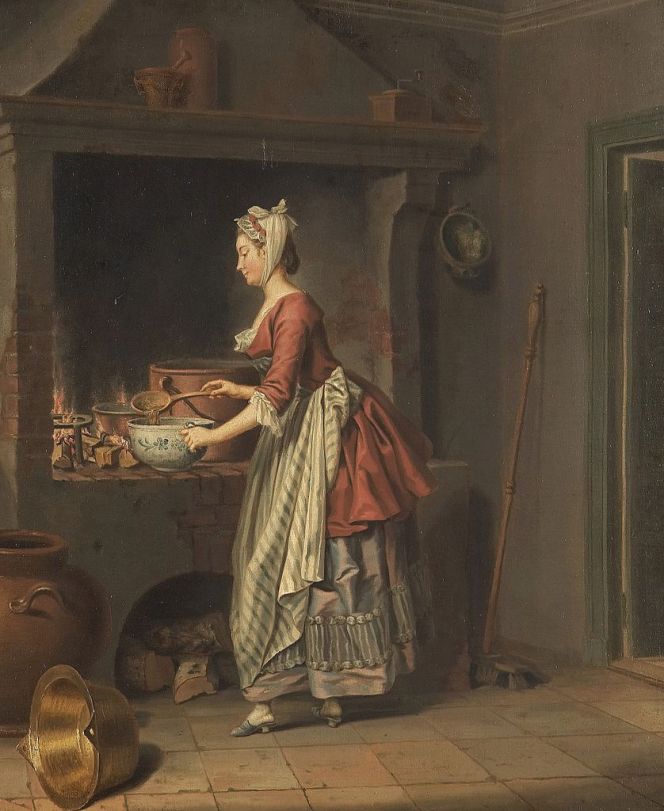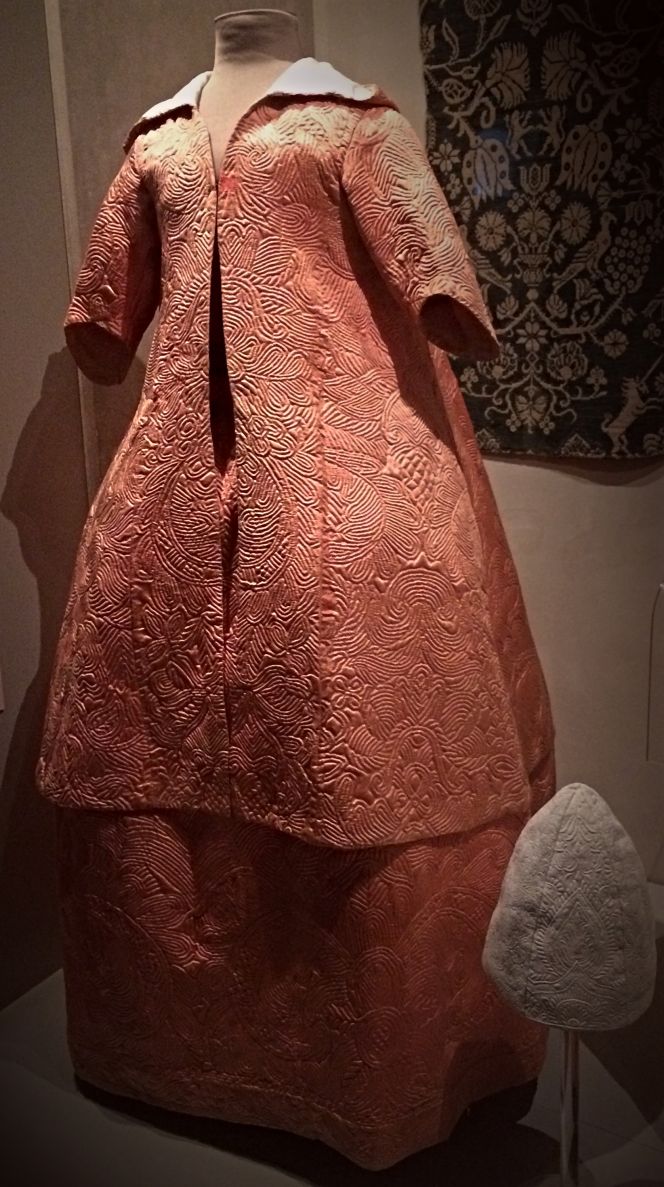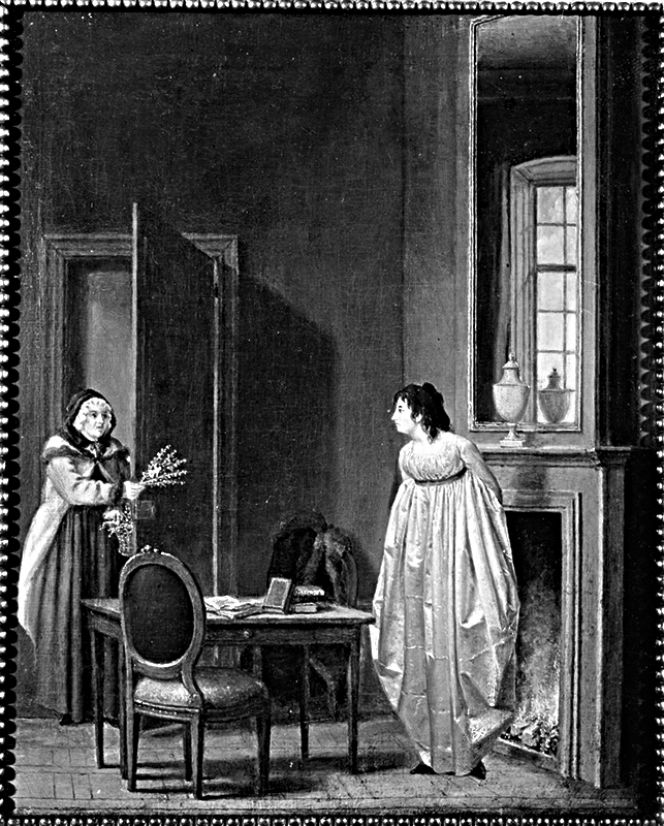ikfoundation.org
The IK Foundation
Promoting Natural & Cultural History
Since 1988


 Crowdfunding Campaign
Crowdfunding Campaignkeep knowledge open, connected, and growing on this textile history resource...
FIREPLACES AND HEATING
– at a Manor House in 1758
Quilted silk or cotton garments and woollen furnishing textiles were essential for keeping warm in high-ceiling manor houses in northern climes. Just as large open fireplaces, assisted by servants at all possible hours of the day via the long line of people from cutting trees to the maid who used ‘one fork with shovel and tongs’ to keep the fire going in the Count’s drawing room. Whilst an ‘English machine of iron to bubble in the fireplace’ may have been some sort of transportable heating item, when feeling frozen or for keeping tea water hot in one of the Countess’ rooms. This essay will look more closely at such traditions, obstacles and possibilities via an 18th century Inventory and a few other contemporary documents from Christinehof Manor House in southernmost Sweden.
 The 1758 Inventory listed seventeen fire places at Christinhof manor house, eight iron/tiled stoves and one tiled stove. Some of these original sources of heat were finely worked in stone and still remain intact. For example this corner located model in the Hall on the first floor, which was already listed in a document of 1741: ’One fire place of cut stone from Gotland and ornamentation of Roman order and wind damper with a handle…’ (Quote from: Mannerstråle, p. 13). Photo: The IK Foundation, London.
The 1758 Inventory listed seventeen fire places at Christinhof manor house, eight iron/tiled stoves and one tiled stove. Some of these original sources of heat were finely worked in stone and still remain intact. For example this corner located model in the Hall on the first floor, which was already listed in a document of 1741: ’One fire place of cut stone from Gotland and ornamentation of Roman order and wind damper with a handle…’ (Quote from: Mannerstråle, p. 13). Photo: The IK Foundation, London.Even during the warmer half of the year, a substantial amount of firewood was needed to keep a three-story manor house of this size reasonably warm. In a rare type of handwritten document, named: ‘Used firewood and coal during the Countess’ and Count’s stay at Christinehof manor house, the year 1758 in July, August, September and October months’ – the consumption was listed. It is noted here that the wood was delivered from the forest farmers of the nearby areas of Andrarum and Torup together with Lilla Wärck or the Alum Works industry, owned by the Piper Family since 1725. The total amount was listed as ’93 fathoms’ [fambn], delivered at regular intervals, more frequently when the autumn progressed. The measure ‘fathom’ for firewood was 3,14 or 3,77 square meters of such wood. Giving evidence that this particular manor house could have used up to 350 square meters of firewood during four months, added with ’83 1/2 barrels of coal’. An enormous consumption – even if used for the kitchen was included – due to the fact that it was summer and early autumn.
 The Swedish artist Pehr Hilleström made several paintings of kitchen interiors from wealthy homes – this detailed example dating circa 1760s-1770s. The wood fired stove, pans and other utensils in picture may be compared with the everyday work in the kitchen at Christinehof manor house. The female servants illustrated in such 18th century interiors are often surprisingly fashionably dressed. However, some practical garments were depicted like a large piece of cloth serving as an apron and the tied fabric on top of the head to keep hair and cap in place. (Sold by Uppsala Auctions Kammare in 2009, unknown present owner, Wikimedia Commons).
The Swedish artist Pehr Hilleström made several paintings of kitchen interiors from wealthy homes – this detailed example dating circa 1760s-1770s. The wood fired stove, pans and other utensils in picture may be compared with the everyday work in the kitchen at Christinehof manor house. The female servants illustrated in such 18th century interiors are often surprisingly fashionably dressed. However, some practical garments were depicted like a large piece of cloth serving as an apron and the tied fabric on top of the head to keep hair and cap in place. (Sold by Uppsala Auctions Kammare in 2009, unknown present owner, Wikimedia Commons).The open fire was the only heating source in the Count’s and Countess’ living spaces on the first floor, in representative guest rooms and the Hall on the second floor. How could these high-consuming fireplaces be so popular? The forests still seemed to be an unlimited resource; together with that, tiled stoves were regarded as inferior in design as well as being less effective for warmth and comfort compared to the open fires in 1758. Changing attitudes became unavoidable already during the coming decades however, due to an increased deforestation. Foremost, a new type of energy-saving tiled stove was invented in the 1760s, which, with its interior pipe system, became a much more economical source for heating a room. A good example of the adjustment in taste within the aristocracy for new such designs may be gleaned via a letter dated May 1763 – from Carl Gustaf to his father, Carl Fredrik Piper, regarding one of the family’s other close-by situated estates. He wrote: ’…On the same occasion, he showed me two pieces of tile samples, which will be used for the tiled stoves at Krageholm manor house and which, to my taste, are excessively beautiful. One with my dear Father’s coat of arms in a cartouche and the other of approximately the same design’.
 A somewhat later (1770s-80s) corded silk quilting is part of a two-piece hooded jacket and skirt, which demonstrates one popular way for a well-to-do lady to keep warm indoors. This type of garments were multi-layered with wadding inserted between the outer fabric and lining, stitched together with backstitch etc in artful motifs. The warming middle-layer could for instance be of silk, cotton, carded wool or linen tow. To my knowledge however, 18th century garments linked the Piper family or other individuals connected to Christinehof manor house have not been preserved. (Collection: Designmuseum Danmark, Exhibition ‘Fashion & Fabric’ 14a-b/1982). Photo: Viveka Hansen in June 2018.
A somewhat later (1770s-80s) corded silk quilting is part of a two-piece hooded jacket and skirt, which demonstrates one popular way for a well-to-do lady to keep warm indoors. This type of garments were multi-layered with wadding inserted between the outer fabric and lining, stitched together with backstitch etc in artful motifs. The warming middle-layer could for instance be of silk, cotton, carded wool or linen tow. To my knowledge however, 18th century garments linked the Piper family or other individuals connected to Christinehof manor house have not been preserved. (Collection: Designmuseum Danmark, Exhibition ‘Fashion & Fabric’ 14a-b/1982). Photo: Viveka Hansen in June 2018.The open fireplaces worked in stone were expensive investments, listed on ten occasions as made of ‘stone from Gotland’, a material which must have been transported by sea about 350 kilometres and then further on poor roads. A few designs were even cut in ‘Roman order’ or ‘Ionic order’. Whilst less luxurious fireplaces, possible to produce with local materials, were listed as two ‘brick walled’, one ‘stonewalled’, and one ‘with wooden frame’ together with a fireplace and baking oven in the kitchen region. Judging by a study of another document linked to this particular manor house, which listed all features in the ‘New House’ in 1741 (Mannerstråle), all rooms in the wings on the first and second floor lacked fireplaces. For all those areas, ‘pipes’ were instead registered, making it likely that the six iron stoves on the ground floor, mentioned in the 1758 Inventory, transported heat upwards to the two floors above via an intricate system of pipes.
 Even if the family mainly lived at Christinehof manor house during late summer and early autumn periods – evenings were chilly. This small size (13x18cm) late 18th century depiction by Pehr Hilleström, is one good comparison of how useful and practical the open fire was as a main source of heat during most of the year. A young woman warms her back between the moments of reading a book on a cold spring day. (Courtesy of: Nordic Museum, Stockholm, Sweden. No. NMA0052681. Wikimedia Commons).
Even if the family mainly lived at Christinehof manor house during late summer and early autumn periods – evenings were chilly. This small size (13x18cm) late 18th century depiction by Pehr Hilleström, is one good comparison of how useful and practical the open fire was as a main source of heat during most of the year. A young woman warms her back between the moments of reading a book on a cold spring day. (Courtesy of: Nordic Museum, Stockholm, Sweden. No. NMA0052681. Wikimedia Commons).This is the ninth essay based on the Inventory dated 1758 at Christinehof Manor House. Quotes from this document, as well as linked correspondence and lists, have been translated from Swedish to English.
Sources:
- Christinehof Manor House, Sweden (research visits, from the late 1980s to 2016).
- Hansen, Viveka, Inventariüm uppå meübler och allehanda hüüsgeråd vid Christinehofs Herregård upprättade åhr 1758, Piperska Handlingar No. 2, London & Whitby 2004 (pp. 18-19 & 38-62).
- Hansen, Viveka, Katalog över Högestads & Christinehofs Fideikommiss, Historiska Arkiv, Piperska Handlingar No. 3, London & Christinehof 2016.
- Historical Archive of Högestad and Christinehof (Piper Family Archive: no D/Ia, E/IIa 2 & F/III a 1).
- Mannerstråle, Carl-Filip, Nya huset i Andrarum Anno 1741, Piperska Handlingar No. 1, Christinehof 1991.
Essays
The iTEXTILIS is a division of The IK Workshop Society – a global and unique forum for all those interested in Natural & Cultural History.
Open Access Essays by Textile Historian Viveka Hansen
Textile historian Viveka Hansen offers a collection of open-access essays, published under Creative Commons licenses and freely available to all. These essays weave together her latest research, previously published monographs, and earlier projects dating back to the late 1980s. Some essays include rare archival material — originally published in other languages — now translated into English for the first time. These texts reveal little-known aspects of textile history, previously accessible mainly to audiences in Northern Europe. Hansen’s work spans a rich range of topics: the global textile trade, material culture, cloth manufacturing, fashion history, natural dyeing techniques, and the fascinating world of early travelling naturalists — notably the “Linnaean network” — all examined through a global historical lens.
Help secure the future of open access at iTEXTILIS essays! Your donation will keep knowledge open, connected, and growing on this textile history resource.
been copied to your clipboard




– a truly European organisation since 1988
Legal issues | Forget me | and much more...
You are welcome to use the information and knowledge from
The IK Workshop Society, as long as you follow a few simple rules.
LEARN MORE & I AGREE







